|
Africa
2024 Journal Pages:
1
2
3
4
5
6
7
8
9
10
11
12
The
huge male lion was stretched out in the middle of the road. He had
a thick dark mane and a taut, sinewy body. It was obvious that he
owned this space; he was not about to give way for anyone who
might want to pass. After all, why should he? He was the
undisputed king of the forest.
The
lion turned his head and met our eyes; his gaze held us
spellbound. He couldn’t have been more than twenty feet from us;
we could see the many battle scars on his face and sides. Then he
sat up, raised his head, and let out a loud and lengthy roar.
His
mighty call started with several short low moans, followed by a
prolonged series of long, escalating roars, and ending with a
series of about twenty short whuffing growls. He put his whole
body into it, his taut muscles straining and his sides heaving
with each resonating note. His voice was challenging yet at the
same time mournful - and very loud.
A
lion’s roar is a deep primal sound that reverberates through
your soul. Nobody could watch and listen to the lion roaring close
up and remain unmoved. With the amazing acoustics provided by
nature, the sound of each roaring note actually echoed, as if he
were deep in a vault. I could feel the sound waves vibrate inside
my chest.
As
our guide and friend Gee would say, ‘Oh my god, my father.’
January
5, 2024
I
arrived at the airport early, excited to get on my flight; I had
really been looking forward to this trip. Along with a group of
both old friends and new, I was embarking on a 16 day mobile
camping safari in Botswana with Makomkom
Safaris, owned and run by my friend Gee Mange. Going on
photo safaris in Africa is my second passion, after horses, and I
was eager to get back to Botswana.
I
reflected on this on the flight to Johannesburg. I had upgraded to
business class with frequent flier miles, so I didn’t really
mind the long travel time. As the plane sailed over the dark and
sleeping continent of Africa, far below I could see clusters of
lights from towns and villages, but from this lofty viewpoint I
could see no highways, and few roads of any sort.
The
towns became fewer, and before long I could see only some tiny
isolated lights that I imagined might be campfires. I envisioned
what the scene below might be like: perhaps a group of young
African boys gathered round, tending their family’s herd of
cattle or goats, building a campfire to ward off predators. They
may have been looking up, watching the giant metal bird glide
overhead, and wondering what it would be like to fly away and
leave their life far behind. This trans-continental flight, though
not too far above them in actual distance, was a million miles
away from the life they knew. With these thoughts in mind, I
drifted off to sleep.
January
6
When
I awoke, the dark blue night sky was hemmed with a fiery rim of
orange and red along the horizon. Waves of rolling clouds below
gradually became visible, like a restless sea kissed by the dawn.
The line between night and day is more tangible when viewed
from above.
I
was flying on Ethiopian Air, courtesy of United frequent flier
miles, and my flight was late into Addis Ababa (Ethiopia). I was
stressing about missing my connection, but one of the airline
staff took me on a runway bus across the tarmac to my next plane,
so I didn’t even have to even go into the terminal. At first I
was worried if my suitcase would make the connection, but when my
departing flight was late as well I figured it would not be a
problem.
I
arrived in Johannesburg (South Africa) in the afternoon, but my
luggage did not. Darn! And the worst thing was Duma was in my
suitcase. Duma is a small stuffed-animal cheetah I had bought on
one of my first Botswana trips, and he had become a safari mascot;
I brought him back to Africa with me on each trip.
I was worried about him - he must be terrified! I hoped we
would be reunited soon.
I
reported my lost luggage to the airline; I hoped it would arrive
on the evening flight, as I would be flying out in the morning for
Maun, Botswana. I found a Woolworths store in the terminal, where
I was able to buy a clean shirt and some socks and underwear. Then
I took a taxi to the Aero Lodge, our accommodations for the night.
I had been traveling for 28 hours since I left home the previous
morning.
|
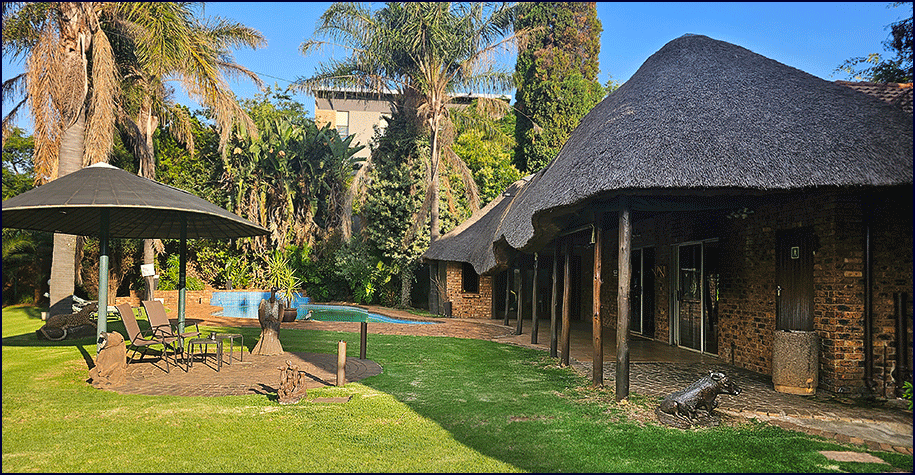
The Aero Lodge |
At the Aero I met up with the rest of our group of seven; I was
actually the last to arrive. Most of us were old friends. Fellow
safari-travelers Natalie and Paula had been on multiple trips with
Gee. My long-time friends Janell and Rafe were both first-timers
to Africa. Lynda and Margot were friends of Paula’s, and proved
to be super new additions to our group. The only thing I was a
little sad about was that my closest friend Jineen was not with
us; she and I have traveled the world together for years, but some
family issues forced her to stay home this time.
|
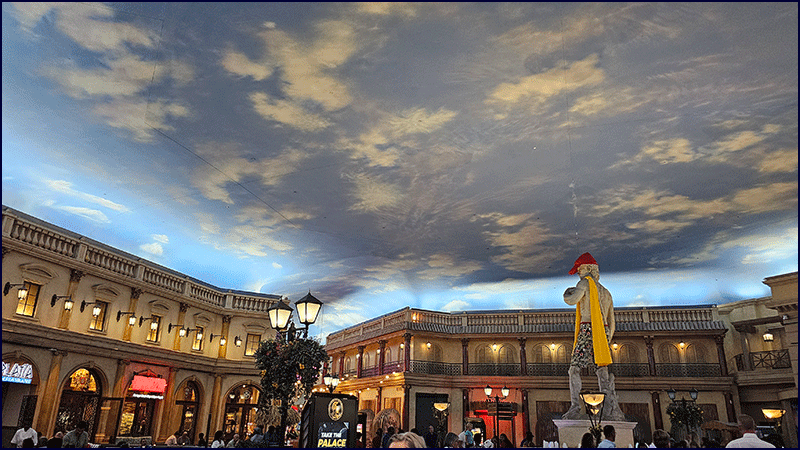
Inside the shopping dome - we couldn't believe we were not
outside!
|
We
took an uber to a restaurant at a mall for dinner; it was inside a
huge dome which was painted on the inside like the evening sky,
with the sun setting and the stars just coming out. It was
amazingly realistic looking; I really felt like I was outdoors. We
had a nice dinner, a few drinks, and lots of laughter. We made a
WhatsApp video toast to Jineen, telling her we missed her. We
headed back to the lodge; most of the others had been in
Johannesburg for a day and had gotten over the jet-lag a little,
but I fell into my bed exhausted.
January
7
A
good night’s sleep, and I was ready to go. After an excellent
breakfast at the lodge I headed to the airport early to check if
my lost bag had arrived on the evening flight from Addis Ababa. It
had not. Maybe this afternoon, they told me, but of course my
flight was leaving before that. A nice lady at the luggage counter
promised to search for my suitcase and put it on a flight to
Botswana when it arrived, but of course I knew that once we
arrived in Maun we would be heading straight out into the bush, so
I was not optimistic. Would I ever see Duma again? I
headed back to Woolworths for a couple more shirts, a baseball
cap, some personal supplies, and a bag to carry them in. Then I
joined the rest of the group and we boarded the flight to Maun,
Botswana.
We
arrived in Maun midafternoon. We collected our luggage (at least
the others did), and after going through Immigration, we rounded
the corner to find Gee standing there holding up a Makomkom
Safaris sign that said ‘DOWSON - 7’. This was
hardly necessary since the airport is tiny and we know Gee well,
but it was a classy touch! I didn’t have the heart to tell him
he had spelled my name wrong. Those of us who knew him gave him a
big hug, and we did introductions all around for those who were
new. It was so great
to see Gee again.
I
had been on four prior trips with Gee, dating back to 2015 when he
was working for a larger safari business, and then more recently
with his own company, Makomkom Safaris. Gee is an exceptional
guide, and he custom designs his safaris to be exactly what his
clients want - which in our case is to spend as much time as
possible out in the bush watching and photographing animals. It
was a mobile safari; we would stay at four different campsites,
with four nights at each. We would spend most of each day on game
drives, exploring the Okavango Delta and Chobe Park.
Gee’s
Toyota Land Cruiser was parked out by the curb. It had three rows
of seats behind the driver, ascending in height, and a small
refrigerator for drinks. Our luggage went on the roof rack, and we
all piled in. Eager to talk with Gee, I rode shotgun, and we were
very comfortable with two people in each row of seats. Gee had
brought a water bottle with the Makomkom logo on it for each of
us; mine was inscribed with ‘Welcome
Back Home.’
People
often ask me why I want to go back to the same places I have been
before, rather than go to somewhere new. There are several reasons
I keep returning to Botswana. The scenery is great, but we mainly
go for the animals, and they provide different experiences each
time. And when I find a place I really like, I enjoy going back
and getting to know the area really well. Also, Botswana has a
more stable government than many African countries, and does a
better job than most at conserving their wildlife and controlling
poaching. But the most important reason I keep returning is Gee;
he is such an outstanding and knowledgeable guide. The experience
we get on the mobile camping safaris with Gee and his staff would
be hard to match anywhere else. And going on safari with Makomkom
does feels a bit like coming home.
We
set off heading north, but stopped at a small grocery store for
Rafe to pick up some Iron Brew, a soft drink she remembered from
her childhood, which apparently can now only be found in southern
Africa. We all sampled her nostalgic purchase; I thought it was
vaguely unpleasant, like a cross between coke syrup and diet Dr.
Pepper, only worse. I don’t think even Rafe liked it very much.
We
headed out of Maun, dodging donkeys, goats, cattle and the
occasional horse, all grazing loose along the side of the road. We
stopped before we left cell service so I could call the lost
luggage department to see if my suitcase had arrived in
Johannesburg; they said it had not, but it had
been located in Addis Ababa and should arrive the following day,
and then they would send it on to Maun. I wouldn’t hold my
breath. Gee arranged for someone to go to the airport the
following afternoon to check on it.
Poor Duma, he must be scared to death.
Presently
we crossed the buffalo fence, a veterinary checkpoint north of
town designed to keep domestic cattle separated from the wildlife,
and then entered the bush. The road became narrower and turned to
sand as we headed to our first camp at a private game reserve
called Kaziikini. Gee folded the windshield down flat; we were now
on safari. A yellow pansy butterfly landed on the steering wheel;
I felt sure that would bring us good luck.
We
started seeing birds right away. The attractive blue Burchell's
starlings and black and white magpie shrikes were a couple of my
favorites. We saw a beautiful paradise whydah with a long
extravagant tail, and a whole flock of grey hornbills, large
handsome birds with substantial curved beaks. There were many
smaller and more common birds as well; while I can’t tell a
white-browed sparrow from a grey-headed sparrow, Gee knew the
difference and could identify them all.
We
arrived at our camp at Kaziikini at around six o'clock. We were
greeted by one of the camp staff holding a tray of cold fruit
juice drinks, served in wine goblets with sugar encrusted rims.
Our camp had four tents and a covered dining area. There were
folding chairs set around a campfire under a tree.
The kitchen and staff tents were a little further off on
the side of camp.
Gee
introduced us to the staff. Our chef was Mosa, who had been on one
of our previous trips; we were thrilled to see him again. Kilos
helped with the cooking, as well as with serving the meals and
general camp chores. More,
a tall strong guy, worked on setting up camp, serving the meals,
and is also a mechanic.
|
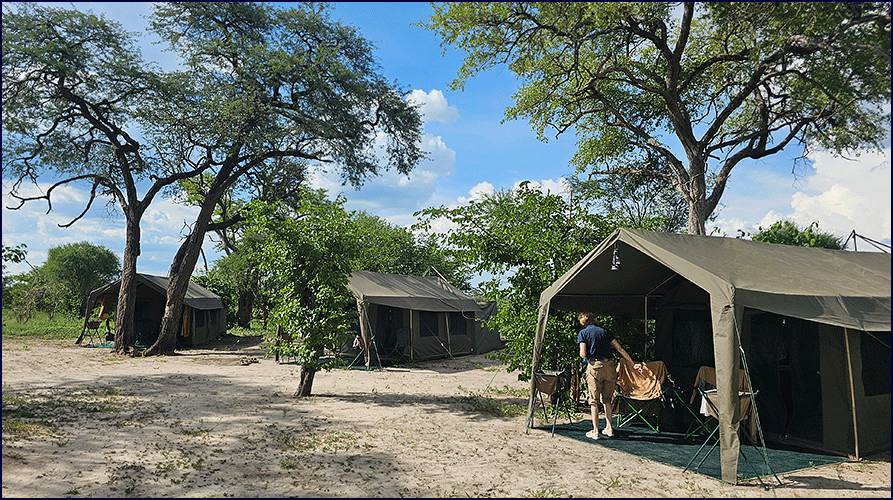
Kaziikini camp |
Gee took us out for a short evening game drive at 6.30. We
speculated on what animal we would see first; it was impala of
course, as we all accurately predicted - they are everywhere.
These graceful antelopes remind me a lot of our white-tailed deer
in Virginia; they are the most common large mammal we see on
safari. They have two-toned brown bodies with thin black markings,
refined features, and the males have graceful long horns.
|
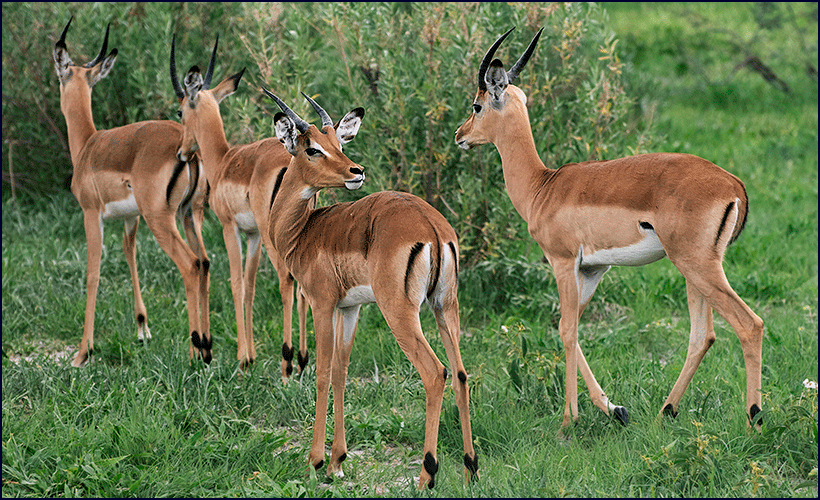
Impalas
|
The
light was fading as we drove across the open plain. Several small
herds of wildebeests and zebras grazed in the distance, and we
spotted four elephants, partially hidden by the trees. It was
great to get our first look at these African icons, and we knew we
would get much closer to them on future drives.
Again
we saw many grey hornbills; I had never seen these handsome birds
in such numbers before. The
ubiquitous red-billed spurfowl, also known as francolins, were
everywhere, making a raucous chatter at dusk. We could always
count on seeing francolins and impalas on every game drive.
|
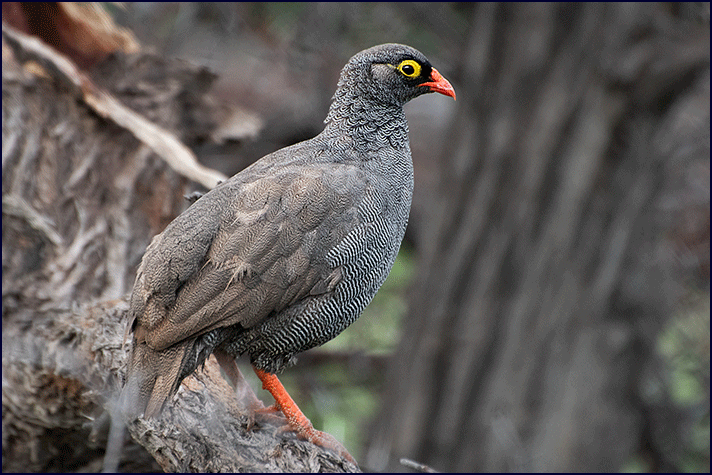
Red-billed spurfowl
|
As
we drove along the sand road someone spotted a patch of brilliant
blue beneath a bush; there was a grey-headed kingfisher on the
ground, and he appeared to be injured. Gee got out to investigate;
the little bird appeared to have a broken wing as he scrambled
away in a panic. We felt sorry for him but could do nothing; there
are strict rules against interfering with nature in the parks.
|
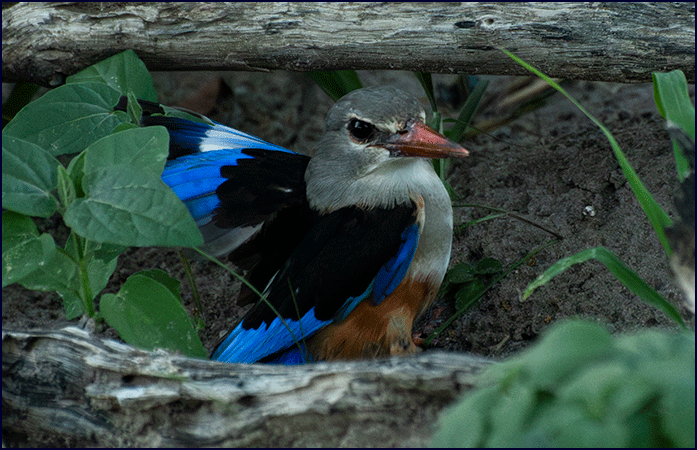
Grey-headed kingfisher |
Darkness
had fallen as we headed back to camp. We could just make out a
lone elephant drinking at a waterhole as we passed by. Our
headlights caught a flash of movement in the road, it was a leggy
night bird called a courser.
Back
at camp, we sat around the campfire with Gee. Most of us had a gin
and tonic or glass of wine, and some snacks were passed around. Following
safari custom, Mosa the chef came to the fire and announced
dinner, telling us what each course would be. He hemmed and hawed
shyly, muttering ‘yep, yep, yep’ after each sentence.
The dinner was superb; it is amazing what excellent meals
Mosa and Kilos were able to cook on a camp stove in the
bush.
After
dinner we went back to the campfire for a while. The stars were
shining brightly in the night sky; not as spectacular as they are
in the Africa in winter, but still beautiful. They shone through
the branches of the spreading tree, and Orion was overhead,
upside-down. Being the rainy season I knew we wouldn’t get the
celestial show we had enjoyed on previous trips in July, but I was
really happy that we were seeing the stars. Perhaps I would get
the opportunity for some night sky photography after all, I
thought, Little did we
know that this would be the last time we would see the stars until
almost the end of the trip. It rained for the next eleven days.
I
would have loved to sit by the fire for hours, but with all the
travel I was exhausted so I headed off to the tent I shared with
Janell. As tired as I was, I had not adjusted to the time
difference and couldn’t go to sleep, but at least that let me
enjoy the night sounds of Africa. As I lay in bed I could hear
hyenas calling, close and often, and lions in the distance in the
early morning. I was excited to see what adventures the morning
would bring.
January
8
Our wakeup call came at 5:30, and
we got up quickly, eager for our first day of game driving. We had
a quick breakfast of toast and jungle oats (oatmeal), and the
world’s best campfire coffee. We were on the road with Gee by
6:30. Kazikiini is a huge game reserve with open plains and areas
of forest. We had not been there before, so we were exploring new
territory.
We followed a sand track across the gently rolling plain.
It was a cloudy morning. The landscape was fairly open, but dotted
with clusters of trees, and there were many waterholes filled by
the rain. There were some forested areas, and also large expanses
filled with the trunks of dead trees, killed by the elephants. The
area is fairly flat, but with some gentle slopes. It
was very serene and quiet, and absolutely wild – other than the
sand tracks of the road we saw few signs of civilization.
We saw a wonderful variety of
birds, right off the bat. I am not going to try to name every bird
we saw (though Gee was certainly able to identify each one), but
rather mention the ones that I found the most interesting or
appealing. We started
off with a purple roller, a beautiful paradise whydah with its
ridiculously long, elegant tail, and an African hawk eagle. We
soon added a pin-tailed whydah to the list, three of them sitting
in a tree, and a pair of European rollers. Cape turtle doves kept
up their steady song, which to me always sounds like they are
chanting, “Bots-wa-na,
Bots-wa-na.”
|
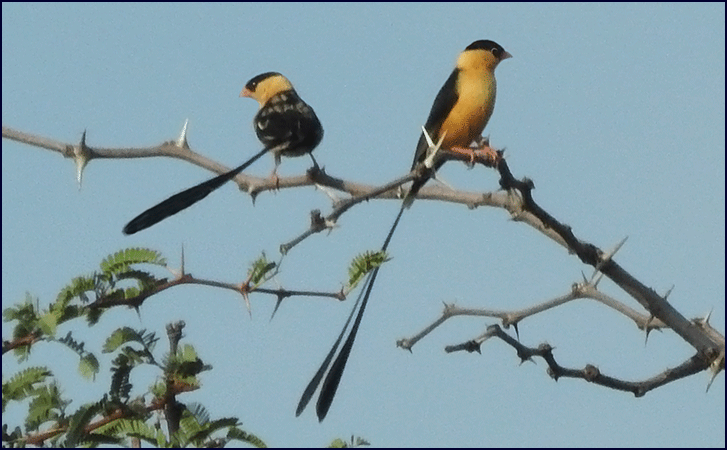
Pin-tailed whydah |
There were plenty of impala about, and we saw two warthogs
though they didn’t let us get close. Then to our delight we came
across three giraffes. They were young males, and they were
play-fighting, swinging their impossibly long necks and whacking
each other with their heads. Giraffes are the most elegant and
gentle-seeming creatures, so it was really interesting to watch
them in mock combat.
We crossed through several areas thick with trunks of dead
trees, both fallen and standing, which had been killed by the
elephants. When they feed, the elephants often push the trees over
to reach the top branches. They will also strip the bark off the
trunks of standing trees, killing them, resulting in the silvery
dead tree-trunks standing ghostlike, with bare branches reaching
toward the sky like grasping hands. Gee says these are known as
Dead Tree Forests.
|
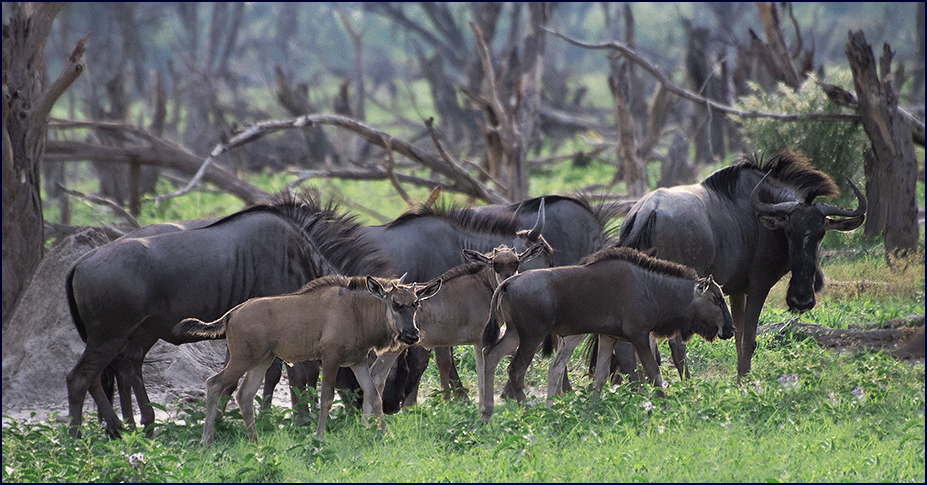
Wildebeests and babies
|
Gee spotted a herd of
wildebeest by a waterhole in the distance, and we headed toward
them. We paused as we saw two black-backed jackals trotting
through the grass, an adult and a half-grown youngster. Jackals
tend to have a negative reputation, but they are really
surprisingly pretty. They look like red foxes, though a little
larger, with refined faces, a reddish brown color, and a
silvery-black back, hence the name.
|
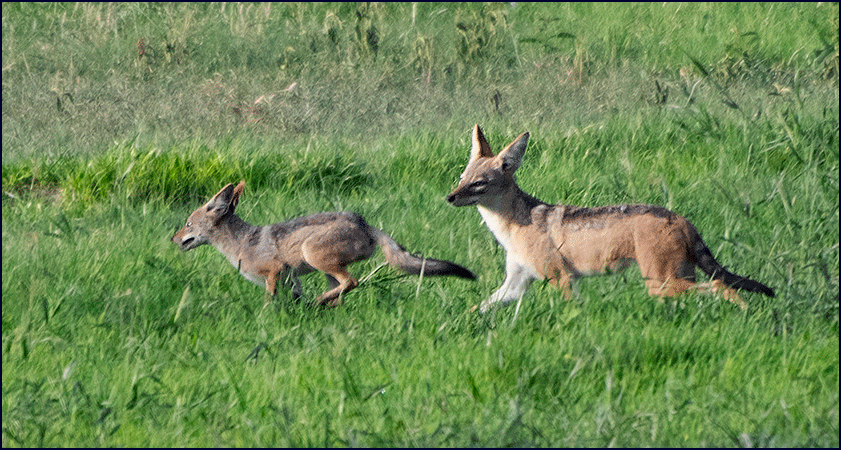
Black-backed
jackals |
We stopped to watch a slender mongoose walking on top of a
fallen tree. His sleek brown body was almost weasel-like, and he
had an inquisitive expression as he gazed back at us. And then we
were distracted by a hunt unfolding off to our right; a jackal was
chasing a baby impala. We watched them streaking across the plain
- as far as we could tell it looked like the impala got away.
There was so much to see, and it seemed the Circle of Life was
unfolding all around us.
|
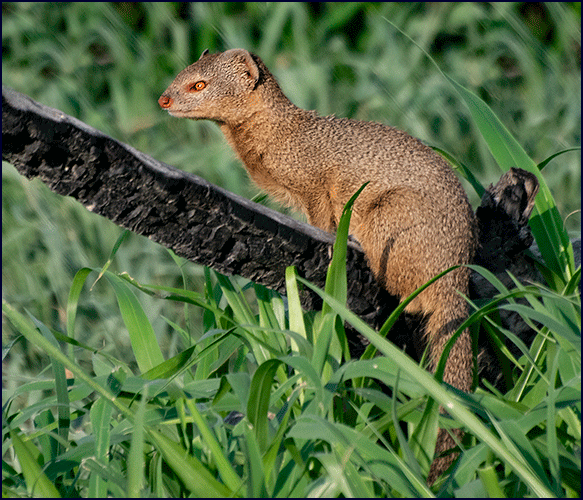
Slender
mongoose |
Presently
we headed over to the wildebeest by the waterhole. It was a small
herd, less than a dozen, and there were a number of young babies
with them. The adult wildebeests are very odd-looking creatures,
with their dark greyish coats, subtly striped necks and comical
looking faces. They have been called the ‘spare parts animal’;
the story is that when God finished making the other animals, he
made the wildebeests out of the parts that were left over. But
their babies are completely different; they were a blondish tan
color, and looked more like domestic calves – you wouldn’t
have thought they were from the same species as their mothers.
A lilac-breasted roller was sitting on a branch with a fat
worm in his beak, our first view of one on this trip. These
vibrant birds are incredible; in addition to their lilac breast,
they have a green head, pink on their cheeks, turquoise underneath
their wings and tails, chestnut brown on their backs, and bright
blue on their wingtips. When they fly, the turquoise and blue
hidden under their wings is brilliantly displayed. We realized the
rollers were doing a mating display; the males would fly up high
from a treetop, and then roll straight down, tumbling toward the
earth, finally pulling up just as you were sure they would be
dashed to pieces on the ground. It was fascinating to watch, and I
am sure the female roller birds found it irresistible.
|
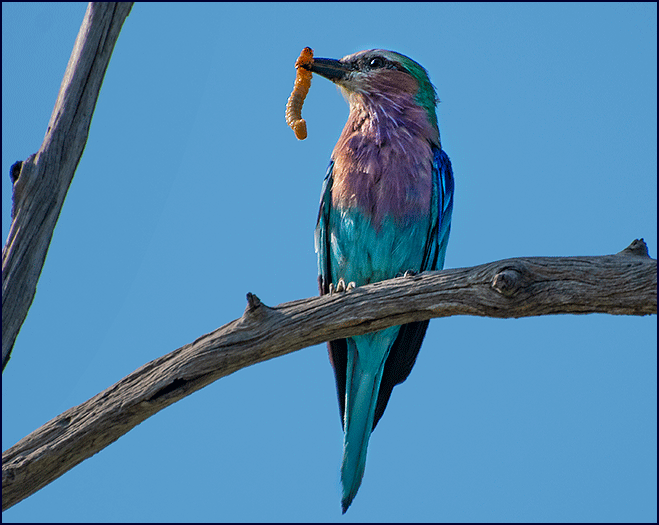
Lilac-breasted Roller |
As we were driving down one of the narrow tracks we saw
motion on our left; to our delight there were elephants at a
waterhole, very close to the road. There were two males, wading in
the water, drinking and throwing mud over themselves. Soon they
were joined by another even bigger male; they moved out of his way
respectfully. We sat and watched them for a long while. More
elephants arrived; soon there were six of them, a bachelor group,
all males.
We
travelled through a long valley, and saw even more elephants. One
very muddy wet bull crossed the road right in front of us.
We stopped about 9.45 and parked under a tree on a knoll
overlooking a large waterhole in the middle of an open field, and
got out to stretch our legs. It was a beautiful spot. Gee brought
out thermoses of hot water to make tea and coffee, as well as
cookies and rusks. We
took our tea break while watching the elephants at the water.
Gee was telling us about his time in
guiding school, specifically as it related to elephants. One
instructor he had was an ‘old school’ type of guide. He taught
that a Level 1 guide had to be able drive safely around the herd
and talk about their behavior. To be a Level 2 guide you had to
walk near an elephant, close enough that it noticed you. To get
Level 3, you had to sneak up behind an elephant and pluck some
hairs from its tail – and not get killed, of course! (I think
this was the guide’s version of an urban legend, but fun to
imagine.)
~
Continued
on next page ~
Africa
2024 Pages:
1
2
3
4
5
6
7
8
9
10
11
12
Back
to the AFRICA 2024 INDEX Page
|